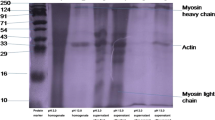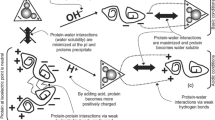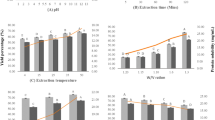Abstract
Study was conducted to use underutilized freshwater mussel (Lamellidens marginalis) for the recovery of proteins using pH shift method and to study the functionality and characteristics of the recovered isolates. From the pH range tested (pH 2.0–13.0), maximum protein yields were obtained during solubilization at pH 2.0 and pH 13.0 (p < 0.05). During the protein recovery process, pH 13.0 was found to have minimal effect on proteins resulting in higher protein yields compared to pH 2.0. Isolates obtained by both acidic and alkaline solubilization processes had low stability and poor gel network. Total lipid content, total myoglobin, and pigment contents were reduced significantly (p < 0.05) during pH shift processing, resulting in whiter protein isolates and protein gels. All the essential amino acids were present in the isolates recovered by acid and alkaline solubilization, indicating the complete recovery of amino acids. No microbial counts were observed in any of the isolates prepared using acid and alkaline-aided processing. Acid and alkaline solubilization (pH shift) process was found to be promising for the recovery of proteins from underutilized freshwater mussel thus by reducing the supply demand gap.

Similar content being viewed by others
References
Álvarez C, Lélu P, Lynch S, Tiwari BK (2017) Optimised protein recovery from mackerel whole fish by using sequential acid/alkaline isoelectric solubilization precipitation (ISP) extraction assisted by ultrasound. LWT Food Sci Technol 88:210–216. https://doi.org/10.1016/j.lwt.2017.09.045
AOAC (2000) Association of official analytical chemists, 16th edn. Washington, DC
Batista I, Pires C, Nelhas R (2007) Extraction of sardine proteins by acidic and alkaline solubilisation. Food Sci Technol Int 13(3):189–194
Bidlingmeyer BA, Cohen SA, Tarvin TL (1984) Rapid analysis of amino acids using precolumn derivatisation. J Chromatogr 336:93–104
Chaijan M, Benjakul S, Visessanguan W, Faustman C (2006) Physicochemical properties, gel forming ability and myoglobin content of sardine (Sardinnella gibbosa) and mackerel (Rastrelliger kanagurta) surimi produced by conventional method and alkaline solubilization process. Eur Food Res Technol 222:58–63
Chaijan M, Undeland I (2015) Development of a new method for determination of total haem protein in fish muscle. Food Chem 173:1133–1141
Chen YC, Tou JC, Jaczynski J (2007) Protein recovery from rainbow trout (Oncorhynchus mykiss) processing byproducts via isoelectric solubilization/precipitation and its gelation properties as affected by functional additives. J Agric Food Chem 55(22):9079–9088
Cortes-Ruis J, Pachero-Aguilar R, Garcia-Sanchez G, Lugo-Sanches ME (2001) Functional characterization of a protein concentrate from bristly sardine made under acidic conditions. J Aquat Food Prod Technol 10:5–23
FAO (2009) Global agriculture towards 2050. High Level Expert Forum Rome, 12–13 October 2009
FAO (2017) The future of food and agriculture; trends and challenges. Rome
Fatin NS, Huda N, David W (2015) Physicochemical properties of Japanese scad (Decapterus Maruadsi) surimi prepared using the acid and alkaline solubilization methods. Int J Sci Eng Res 6(4):141–147
Feng YM, Hultin HO (2001) Effect of pH on the rheological and structural properties of gels of water-washed chicken-breast muscle at physiological ionic strength. J Agric Food Chem 49:3927–3935
Freitas IR, Cortez-Wega WR, Prentice C (2015) Evaluation of properties of protein recovered from fish muscle by acid solubilization process. Int Food Res J 22(3):1067–1073
Freitas IR, Gauterio GV, Rios DG, Prentice C (2011) Functionality of protein isolates from argentine anchovy (Engraulis anchoita) residue using pH shift processing. J Food Sci Eng 1:374–378
Haldar A, Dey TK, Dhar P, Chakarabarti J (2014) Exploring the nutritive values of the fresh water mussel Lamellidens marginalis as potential functional food. IOSR J Env Sci Toxicol Food Technol 8(8):1–7
Hamm R (1994) The influence of pH on the protein net charge in the myofibrillar system. Rec Meat Conf Proc 47:5–9
Harlow E, Lane D (1988) Antibodies: a laboratory manual. Cold Spring Harbor Laboratory Press, New York
Huang L, Chen Y, Morrissey MT (1997) Coagulation of fish proteins from frozen fish mince wash water by ohmic heating. J Food Process Eng 20:285–300
Hultin HO, Kelleher SD (1999) Process of isolating a protein composition from a muscle source and protein composition. Patent US6005073
Hultin HO, Kelleher SD (2000) High efficiency alkaline protein extraction. Patent US6136959
Huss HH (1983) Fresk Fisk K valitet Og Holdbarhed. Fiskeriministeriets Forsφgslaboratorium
Jafarpour SA, Shabanpour B, Filabadi SS (2013) Biochemical properties of fish protein isolate (FPI) from silver carp (Hypophthalmychthis molitrix) by application of acid-alkali process compared to traditional prepared surimi. Ecopersia 1(3):315–327
Jay JM (1986) Modern food microbiology. Van Nostrand Reinhold Company, New York
Jongjareonrak A, Rawdkuen S, Chaijan M, Benjakul S, Osako K, Tanaka M (2010) Chemical compositions and characterization of skin gelatin from farmed giant catfish (Pangasianodon gigas). LWT Food Sci Technol 43:161–165
Kelleher SD, Hultin HO (2000) Functional chicken muscle protein isolates prepared using low ionic strength, acid solubilisation/precipitation. Rec Meat conf Proc 3:76–81
Kinsella JE (1976) Functional properties of proteins in foods, a survey. CRC Crit Rev Food Sci Nutr 7:219–280
Kristinsson H, Demir N (2003) Functional fish protein ingredients from fish species of warm and temperate waters: comparison of acid- and alkali-aided processing vs. conventional surimi processing. In: Betchel P (ed) Advances in seafood byproducts 2002 conference proceedings. Alaska Sea Grant College program University of Alaska, pp. 277–295
Kristinsson H, Ingadottir B (2006) Recovery and properties of muscle proteins extracted from tilapia (Oreochromis niloticus) light muscle by pH shift processing. J Food Sci 1(3):E132–E141
Kristinsson HG, Liang Y (2006) Effect of pH-shift processing and surimi processing on Atlantic croaker (Micropogonias undulates) muscle proteins. J Food Sci 71:C304–C312
Kristinsson H, Theodore AE, Demir N, Ingadottir B (2005) A comparative study between acid- and alkali-aided processing and surimi processing for the recovery of proteins from channel catfish muscle. J Food Sci 70(4):C298–C306
Kudo G, Okada M, Miyauchi D (1973) Gel-forming capacity of washed and unwashed flesh of some Pacific coast species of fish. Marine Fish Rev 32:10–15
Laemmli UK (1970) Cleavage of structural proteins during assembly of the head of bacteriophage T4. Nature 227:680–685
Lubana GK, Kaur B, Surasani VKR (2016) Quality changes in fresh rohu (Labeo rohita) cutlets added with fibers from ragi, oat and jowar. Nutr Food Sci 46(4):571–582
Marmon SK, Undeland I (2010) Protein isolation from gutted herring (Clupea harengus) using pH-shift processes. J Agric Food Chem 58:10480–10486
Mutilangi WAM, Panyam D, Kilara A (1996) Functional properties of properties of hydrolysates from proteolysis of heat-denatured whey protein isolate. J Food Sci 61(2):270–274
Niki H, Kato T, Deya E, Igarashi S (1985) Recovery of protein from effluent of fish meat in producing surimi and utilization of recovered protein. Nippon Suisan Gakkaishi 51(6):959–964
Nolsøe H, Undeland I (2009) The acid and alkaline solubilization process for the isolation of muscle proteins: state of art. Food Bioprocess Technol 2:1–27
Nolsφe H, Marmon SK, Undeland I (2011) Application of filtration to recover solubilized proteins during ph-shift processing of blue whiting (Micromesistius poutassou); effects on protein yield and qualities of protein isolates. Open Food Sci J 5:1–9
Panpipat W, Chaijan M (2016) Biochemical and physicochemical characteristics of protein isolates from bigeye snapper (Priacanthus Tayenus) head by-product using pH shift method. Turk J Fish Aquat Sci 16:41–50
Rawdkuen S, Sai-Ut S, Khamsorn S, Chaijan M, Benjakul S (2009) Biochemical and gelling properties of tilapia surimi and protein recovered using an acid-alkaline process. Food Chem 112:112–119
Reddy SVK (2016) Effect of formulation and processing methods on the quality and acceptability of cutlets made from minced meat of pangas (Pangasius pangasius). SAARC J Agric 14(1):25–36
Robinson HW, Hogden CG (1940) The biuret reaction in the determination of serum proteins. J Biol Chem 135:707–725
Sathe SK, Deshpande SS, Salunkhe DK (1982) Functional properties of lupin seed (Supinus mutabilis) proteins and protein concentrates. J Food Sci 7:191–197
Shabanpour B, Etemadian Y, Taghipour B (2015) Physicochemical and rheological parameters changes for determining the quality of surimi and kamaboko produced by conventional, acid and alkaline solubilization process methods from common kilka (Clupeonella cultriventris caspia). Iran J Fish Sci 14(4):826–845
Surasani VKR (2017) Influence of rohu (Labeo rohita) deboning by-product on composition, physical properties and sensorial acceptability of rohu cutlets. Nutr Food Sci 47(3):398–408
Surasani VKR (2018) Acid and alkaline solubilization (pH shift) process: a better approach for the utilization of fish processing waste and by-products. Env Sci Pollut Res 25:18345–18363. https://doi.org/10.1007/s11356-018-2319-1
Surasani VKR, Khatkar SK, Singh S (2017a) Effect of process variables on solubility andrecovery yields of proteins from pangas (Pangasius pangasius) frames obtained by alkalinesolubilization method: characteristics of isolates. Food Bioprod Process 106:137–146
Surasani VKR, Tyagi A, Kudre T (2017b) Recovery of proteins from rohu processing waste using ph shift method: characterization of isolates. J Aquat Food Prod Technol 26(3):356–365
Surasani VKR, Kudre T, Ballari RV (2018) Recovery and characterization of proteins from pangas (Pangasius pangasius) processing waste obtained through pH shift processing. Env Sci Pollut Res 25:11987–11998. https://doi.org/10.1007/s11356-018-1456-x
Tian Y, Wang W, Yuan C, Zhang L, Liu J, Liu J (2016) Nutritional and digestive properties of protein isolates extracted from the muscle of the common carp using pH shift processing. J Food Process Preserv 41:e12847. https://doi.org/10.1111/jfpp.12847
Undeland I, Kelleher SD, Hultin HO (2002) Recovery of functional proteins from herring (Clupea harengus) light muscle by an acid or alkaline solubilization process. J Agric Food Chem 50(25):7371–7379
Vareltzis PK, Undeland I (2012) Protein isolation from blue mussels (Mytilus edulis) using an acid and alkaline solubilisation technique—process characteristics and functionality of the isolates. J Sci Food Agric 92(15):3055–3064
Yusufzi SI, Singh H, Shirdhankar MM (2010) An evaluation of different methods for transportation of the freshwater mussel Lamellidens corrianus (Lea 1834). Int J Aqua 18(4):676–692
Acknowledgements
Authors wish to express their sincere thanks to the Dean, College of Fisheries, Guru Angad Dev Veterinary and Animal Sciences University, Ludhiana, India, for the support and facilities provided during the work period. Authors wish to express their sincere thanks to Mrs. Manvinder Kaur for her technical help during the manuscript preparation.
Author information
Authors and Affiliations
Corresponding author
Additional information
Responsible editor: Philippe Garrigues
Rights and permissions
About this article
Cite this article
Surasani, V.K.R., Mandal, A. & Pandey, A. Utilization of freshwater mussel (Lamellidens marginalis) for the isolation of proteins through pH shift processing: characterization of isolates. Environ Sci Pollut Res 25, 31497–31507 (2018). https://doi.org/10.1007/s11356-018-3154-0
Received:
Accepted:
Published:
Issue Date:
DOI: https://doi.org/10.1007/s11356-018-3154-0




